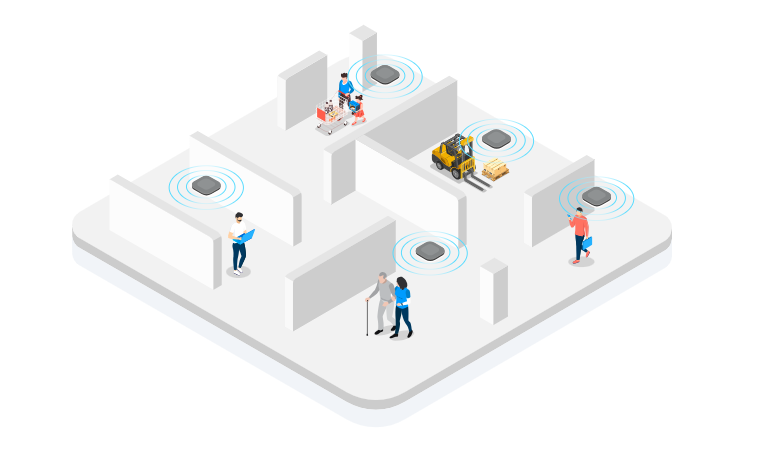In modern hospital management, improving operational efficiency, ensuring patient safety and optimizing resource allocation are the core goals. With the rapid development of Internet of Things technology, real-time location systems (RTLS) have become a key technical means to achieve these goals. RTLS provides hospitals with real-time monitoring and management capabilities for personnel, assets and equipment through high-precision positioning technology, opening a new chapter in the intelligent transformation of hospitals.

Technical principles and core advantages of RTLS
RTLS is a signal-based radio positioning method that uses active or passive sensing technology to achieve positioning. Active RTLS includes AOA (angle of arrival positioning), TDOA (time difference of arrival positioning), TOA (time of arrival) and other technologies, which can provide centimeter-level high-precision positioning services. Unlike traditional GPS positioning, RTLS is particularly suitable for indoor environments, solving the problem that satellite signals cannot penetrate buildings.
Its core advantages are reflected in:
High-precision positioning: RTLS systems based on AOA, TDOA and other technologies have positioning accuracy of up to centimeters, and can accurately track the location of personnel, assets and equipment in hospitals.
Real-time: The system can provide real-time location information of the located object, ensuring that hospital managers can keep abreast of the dynamic situation in the hospital.
Strong anti-interference ability: With special signal processing technology, RTLS can resist interference such as multipath effect and noise, ensuring the accuracy and stability of positioning.
Scalability and compatibility: The RTLS system can be easily integrated with other IoT devices, has strong scalability, and supports a variety of wireless communication technologies, such as Bluetooth, UWB, etc.
Application scenarios of RTLS in hospitals
Patient tracking and management
RTLS technology can track the location of patients in real time to ensure the safety of patients in the hospital. For example, for patients with dementia or other cognitive impairments, the RTLS system can prevent them from getting lost and alert staff when patients enter areas they should not enter. In addition, by tracking the patient's stay in the operating room, before and after surgery, the RTLS system can optimize patient flow, reduce waiting time, and improve operating room utilization.
Asset and equipment management
There are many assets and equipment in the hospital, and the RTLS system can achieve real-time positioning and tracking of these assets and equipment. Through tags attached to assets and equipment, the RTLS system can accurately identify their location and status, reduce the time spent looking for equipment, and improve asset utilization. For example, in the operating room, the RTLS system can track the location of key assets such as infusion pumps and wheelchairs to ensure that they can be quickly found and used when needed.
Employee positioning and scheduling
The RTLS system can also achieve real-time positioning and scheduling of hospital employees. By wearing positioning tags for employees, hospital managers can grasp the location and work status of employees in real time, optimize personnel allocation, and improve work efficiency. For example, in an emergency, the RTLS system can quickly locate and dispatch the nearest medical staff to deal with it.
Infection control and hand hygiene monitoring
The RTLS system also plays an important role in infection control. By integrating an electronic hand hygiene compliance monitoring system, RTLS can monitor whether medical staff wash their hands when entering and leaving the ward, and automatically collect hand washing compliance data. This helps hospitals review hand hygiene processes, improve hand hygiene compliance, and reduce the spread of hospital-acquired infections.
Implementation cases and effect verification of RTLS
Implementation cases
A large hospital has achieved real-time positioning and tracking of patients, assets and equipment by deploying the RTLS system. After the system is launched, hospital managers can grasp the dynamic situation in the hospital in real time, optimize patient processes and improve the utilization rate of operating rooms. At the same time, by tracking the location and status of assets and equipment, the hospital has reduced the time to find equipment and improved asset utilization. In addition, the RTLS system has also played an important role in infection control, improved hand hygiene compliance, and reduced the spread of hospital-acquired infections.
Effect verification
After implementing the RTLS system, the hospital has achieved remarkable results. Patient waiting time has been reduced, operating room utilization has been improved, asset utilization has been optimized, and hand hygiene compliance has been improved. These improvements have not only improved the hospital's management efficiency and service quality, but also enhanced patients' sense of security and satisfaction.
Future prospects: Deepening application of RTLS in hospitals
With the continuous development of IoT technology, the application of RTLS in hospitals will be further deepened. In the future, the RTLS system will be integrated with more IoT devices to achieve a higher level of automation and intelligent management. For example, by integrating with smart medical devices, electronic medical record systems, etc., the RTLS system can provide more comprehensive patient information and management data, supporting hospital managers to make more scientific decisions. In addition, the RTLS system will also play a greater role in hospital safety, environmental monitoring, etc., providing hospitals with all-round protection and support.
RTLS technology provides hospitals with real-time monitoring and management capabilities for personnel, assets and equipment with its advantages of high-precision positioning, real-time performance, and strong anti-interference ability. From patient tracking and management to asset and equipment management, from employee positioning and scheduling to infection control and hand hygiene monitoring, the RTLS system has a wide range of application scenarios in hospitals and has significant effects.